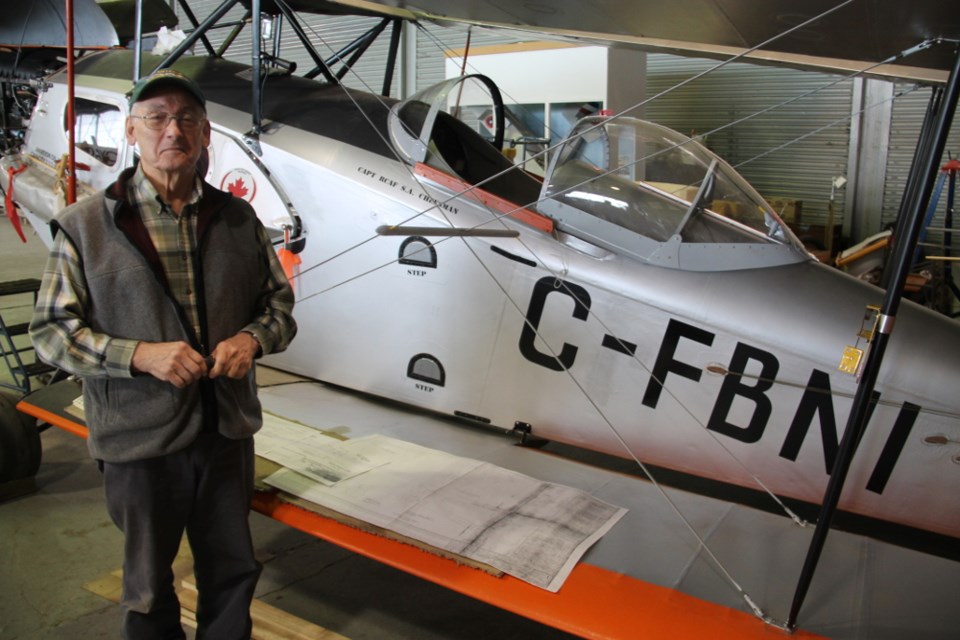John Lalonde says “I’ve always been involved in long-term projects.”
One long-term project in which the Canadian Bushplane Heritage Centre volunteer played a major part in is the all-but-complete construction of a de Havilland Fox Moth reproduction aircraft.
With a team of 14 volunteers, John began building the plane at the Bushplane Museum in 1997.
“Right now we’re just hooking up the exhaust system and that’ll be it,” John told SooToday.
The de Havilland Fox Moth was a small biplane passenger aircraft invented in the United Kingdom in 1932, 98 of which were built and flown in the UK, another 53 built and flown in Canada (with a distinct DH.83 Canadian categorization).
“It’s quite significant, this aircraft. None of the originals survived,” John said.
“This is Canadian history. If we hadn’t finished it, the children of today would not have known how significant it was in developing the north and the arctic. Some Canadian airlines started with the Fox Moth. Bearskin Airlines, which flies into the Sault, had one.”
The Moth’s wings fold in for easy storage.
The plane can carry three passengers (or cargo) in a tiny compartment in front of the pilot’s cockpit.
“Back in the early 1930s people were only five feet tall and weighed about 120 pounds. On one seat there’s a notch in the middle for seat belts. There would be about 18 inches for your hips. It would be a tight fit,” John chuckled.
“It’s quite durable,” said John of the Moth, which is built with a waterproof plywood fuselage.
“Five years ago there were three to five people here every day, conscientiously working on it”
“We built it by hand. We scrounged everything we could,” John said of his attempt to find and use as many original Fox Moth parts as possible, such as the oil tank and fuel tank, obtained from various locations across Canada.
John said he has over 200 photographs of the process on file.
The plan is for the Fox Moth to be taken to the Sault Ste. Marie airport next year (depending on government paperwork, John said) and flown on a special occasion by pilot Dave Hadfield, brother of Canadian astronaut Chris Hadfield.
While a team of dedicated volunteers worked countless hours on the Fox Moth, John has been described by many as the driving force behind it.
“I would say I was ‘quality control’ in most cases.”
“A lot of times they would do something and I would say ‘that’s not good enough, do it over again.’ They weren’t happy sometimes,’” John laughed.
“The aircraft skeleton was on the floor and we decided we would finish it here on the floor or scrap it. They asked ‘anybody want to work on it?’”
John took the project on “as a body willing to get involved.”
“I didn’t know what I was getting into. I didn’t know anything about this aircraft, its not well known in Canada (though many were built in this country).”
John found as many design drawings of the Fox Moth as he could and went from there.
“Another fellow and me, all he and I did for three months was go through the drawings and catalogue them. There are over 1,500 sheets.”
John and his team of volunteers were sure to honour two men involved in aviation when putting the reproduction together.
RCAF Capt. Al Cheesman’s name is painted on the surface of the plane just below the cockpit, while near the passenger door, there appears the name of his son, Dr. Ken Cheesman (a local dentist who was involved in the Fox Moth project, killed in the mid-1990s in a plane crash north of Sault Ste. Marie).
John, now 77, was born in Saskatoon, raised in Vancouver, and joined the RCAF in 1957, becoming highly skilled in electronics.
He retired from the air force in 1980 and went to work for Transport Canada at the Sault Ste. Marie airport.
When John, a married father and grandfather, retired from Transport Canada in the mid-1990s, he devoted much of his time to volunteering at the Canadian Bushplane Heritage Centre.
“I always liked aircraft, it was a hobby of mine, so it was a natural thing to come to the Bushplane Museum,” said John, who plans to keep working on various aircraft projects.
